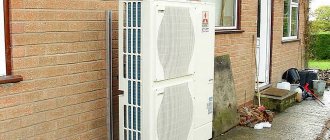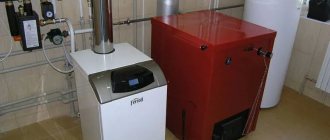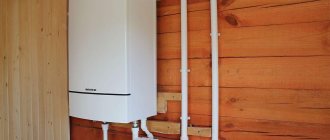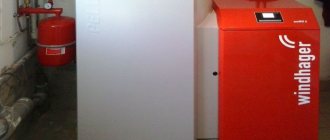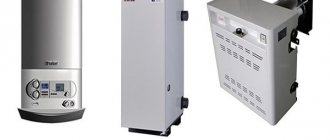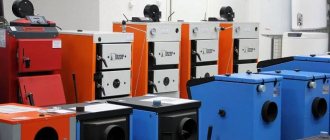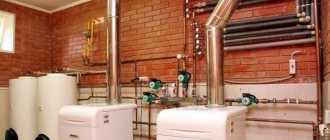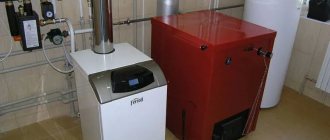An electric boiler for heating a house of 50 square meters is an environmentally friendly device that is easy to install. Its operation does not require special knowledge, premises, pipes or chimneys. Its cost is lower than the price of units operating on other types of fuel.
The models have low power and operate from a 220 V network through a connection to a home outlet. Energonadzor permission is not required to use the equipment. You can install the installation yourself.
What requirements must an electric boiler meet for heating a private house of 50 sq.m?
To heat a room, you need a unit of the required power, which is easy to calculate. For example, you can make calculations for a house in central Russia, with walls 2 bricks thick and a ceiling height of 2.7 m. In such a room, heating is carried out using equipment with a value of 1 kW per 10 sq.m of area. A boiler with a power of at least 5 is suitable for a home. To compensate for possible heat losses through poorly insulated walls, windows and doors, add 20%. The final figure increases to 6.
This method works in 95% of cases. Specialists will help you carry out calculations in other climatic zones. They will take into account the power of radiators, glazing area and other factors.
Saving on finances
Let's remember right away: by saving money, you will never get the most economical and profitable heating for a private home. This is the main mistake of all developers. You invest money in building a big house, in decorating the outside and inside, but most often you forget about such fundamental things as heating.
Heating costs money, but you can still save money wisely. You can install the good old and proven gravity radiator heating system. It will be affordable and you will provide your home with warmth during the cold season. But this will not be the most economical heating system.
Types of electric boilers for heating a home
Units vary in heating method. Most often, heating elements are installed in small individual houses. They are found in 90% of private buildings and are tubular electric heaters. Inside the structure, made of metal, there is a spiral. During operation, it heats up and transfers energy to the heating element body and the coolant, which is often water.
Most of these boilers have a compact, rectangular, hinged body that houses a circulation pump, a safety valve, various sensors, an expansion tank and an air vent. Mounting and installation involves hanging the device on brackets mounted in the wall. Later, water pipes are connected to it to supply cold liquid and obtain hot liquid. When the power cord is connected to the network, the boiler starts working.
Electrode (ionic) devices are based on heating water due to the movement of ions between electrodes. Water under the influence of electric current decomposes into molecules, which change direction of movement 50 times per second. As a result, the liquid is heated without scale formation. This is a reason to use hard, unfiltered water in the system.
An electrode boiler is more economical than a heating element. It has constant efficiency. Some difficulties arise when installing the safety group, expansion tank and pump.
Induction devices use a coil with a core as a heater. When voltage is applied, a magnetic field is formed in it, creating Foucault currents that increase the temperature of the coolant. Water heats up 1.5-2 times faster than in similar structures of other types. No scale is formed. Instead of water, you can use oil, antifreeze or glycerin.
Schemes of water heating systems
I consider the issue of the cost of one- and two-pipe types of construction not so fundamental; in the opinion of most people, the first heating system will cost less, but only when it comes to small buildings. The second heating circuit will not be able to function as efficiently as possible without thermostatic valves, and slightly more radiators will need to be installed than in the first option.
Single-pipe wiring: pros and cons
An important positive side will be the length of the circuit and the pipeline, because thanks to this indicator they do not affect each other in any way. The connection is quite simple, and the ability to install the system in multi-storey buildings makes it practical. The main pipe looks quite aesthetically pleasing; it is located parallel to the baseboard.
Among the disadvantages, I can note the mandatory installation of additional equipment due to the serial connection of radiators, otherwise the last point will not be able to properly generate heat. This process will affect cash costs, and the heat exchange area will increase.
Advantages of a two-pipe connection:
- Versatility and simplicity.
- Maximum concealed pipe placement.
- Hydraulic balance.
- Possibility to connect many radiators to one coolant.
Advantages and disadvantages
Electric heating systems have a number of advantages.
These include:
- no need to install a chimney;
- efficient and silent operation;
- no open flame;
- compact dimensions;
- affordable prices;
- connecting the boiler to the “Warm Floor” system and to the boiler.
Noticed shortcomings:
- relatively expensive fuel in the form of electrical energy;
- impossibility of using equipment over large areas.
The units have many more advantages than disadvantages. This is a reason to increase demand for products.
Additional ways to save
Additional heating savings can be obtained by installing control equipment:
- If you have radiators, thermostatic heads will not be amiss. They are installed on the radiator supply instead of conventional valves. They perform a simple function - at the desired temperature in the room, they shut off the supply, and when the room cools down, they open it back up. The adjustment is only relevant for heating systems with forced circulation
- If you have heated floors, then it would be a good idea to install a manifold with servo drives and install a thermostat in each room. The servo drive is interfaced with the thermostat and when the required temperature in the room is reached, it shuts off the coolant supply to the heated floor circuit
Criteria for choosing an electric boiler
Good heating devices work in winter and summer without interruption. To save energy consumption, the power of the device is regulated. It must be environmentally friendly and not emit soot, ash, smoke and other combustion products. The compactness and performance of the boiler are of great importance.
When choosing equipment for a private home, it is necessary to evaluate the following parameters:
- room area;
- type of product;
- installation method;
- food type;
- control system;
- additional features.
The simplest way to determine area is to multiply the width of the room by its length. By type, boilers are divided into two- and single-circuit. The former are able to simultaneously heat the house and provide it with hot water. The second is to only provide heat. To perform both tasks, a boiler is attached to it. Floor-mounted devices are more powerful than wall-mounted ones, which are characterized by small overall dimensions and weight. Their indicators are enough to heat a small house.
The units have several working elements. The power of each is 1.5 kW. They receive power from a 380 or 220 V network. A display is built into the housing to display information about the operation of the heating device. Control can be intelligent and via a smartphone. Sensors determine the outside and inside temperatures and set the desired operating mode of the device. The heater can be connected to the Smart Home system.
Additional features include economical modes, emergency shutdown sensors, remote control, protection against temperature rise or freezing.
Is it worth buying a boiler that is too powerful?
Modern heating equipment is equipped with automatic systems that allow you to regulate gas flow. This is very convenient because it eliminates unnecessary expenses. It may seem that an accurate calculation of the power of a heating boiler is not so important, because you can simply buy a boiler with high power ratings. But it's not that simple.
Correct selection of heating equipment will extend its service life
Unreasonably exceeding the thermal power of equipment can lead to:
- increasing costs for the acquisition of system elements;
- reducing the efficiency of the boiler;
- failures in the operation of automatic equipment;
- rapid wear of components;
- formation of condensation in the chimney, etc.
Thus, you need to try to “get into” exactly the power that suits your home.
Most popular models
The best heating element type boilers with a power of 6 kW:
“EVAN EPO-6” is a simple and reliable device of compact size, controlled from a remote control. Protected from excessive overheating. The price corresponds to the quality. Equipped with automatic step power control.
“EVAN Warmos-IV-6” is a model with a built-in pump, a set of valves and sensors, and an expansion tank. Everything is housed in a standard case. The device is equipped with autodiagnostics, an antifreeze system and protection against excessive overheating. The power control device operates in steps. There are some complaints about the assembly.
“Protherm Skat 6 KR 13” is a reliable device made in Poland, characterized by build quality and durability. The heating elements are placed in a flask, which ensures safety and energy savings.
Vaillant eloBLOCK VE 6 is a German heater for small houses. It has efficient multifunctional automation, stylish design, and additional thermal insulation.
Electrode type models:
“Galan OCHAG 6” is a reliable boiler in the budget price category. Power – 6 kW. Equipped with a simple but functional automatic machine. It is recommended to use a special coolant produced by the same company.
Beril 6 kW 230-400V – model made in Latvia. Multifunctional and reliable, with the ability to connect remote control.
Induction devices:
“VIN-5” is the only 5 kW boiler. Remote control control. It has a long period of trouble-free operation.
Several other units:
“EVAN Next 7” is a compact heater with easy installation. Comfortable use is ensured by electronic control. Efficiency – 99%, power – 7 kW. Heats an area of up to 70 m². The coolant heats up to 85°C. Boiler dimensions – 20.5x60x10.5 cm, weight – 8 kg.
ZOTA 9 Lux is a model with remote operation control. The coolant has a temperature from 30 to 90°C. Installation dimensions – 29x73x16 cm, weight – 18 kg. There is a convenient display, the heater is protected from freezing. It is possible to service underfloor heating.
“EVAN Next 3” is a copy for heating small houses. High-quality housing, protected from corrosion. Radiators heat up to 85°C. Overall dimensions 20.5x60x10.5 cm, weight - 8 kg.
“Reko 6P” is a universal electric boiler for heating a house, 380V and 220V, equipped with heating elements made from stainless steel. It has a modern attractive design and a reliable tank. There is a programming function. Heater dimensions – 30x50x19.5 cm, weight – 12 kg.
ZOTA 6 Econom is a boiler that operates autonomously and maintains the temperature set by the owners. Manufactured using stainless steel sheets. Case dimensions – 18.5x46x12 cm, weight – 5.5 kg.
Prices: summary table
| Model | Type | Cost, rub. |
| EVAN EPO-12 | heating elementnew | 8 200-12 400 |
| EVAN Warmos-IV-12 | heating elementnew | 14 000-19 500 |
| Protherm Skat 12 KR 13 | heating elementnew | 32 000-39 000 |
| Vaillant eloBLOCK VE 12 | heating elementnew | 34 000-41 000 |
| Galan Geyser 15 | electrode | 4 100-4 500 |
| Beryl-12 Ion | electrode | 4 500-9 000 |
| Alternative energy VIN-5 | induction | 30 000-42 000 |
How to choose the right gas boiler
To choose the right gas boiler, take into account the following criteria:
- Purpose. The boiler is needed only to heat the room or also to supply hot water;
- Installation method. Floor-standing boilers are used for rooms up to 200 square meters and are hung inside the house. Wall-mounted models take up more space and are used for heating spacious cottages. Such products require a separate boiler room;
- Material of manufacture. Wall-mounted boilers are made of copper, floor-standing boilers are made of steel and cast iron. The latter are more durable and reliable materials;
- Presence of a chimney. Please note that there are strict requirements for the installation of chimneys. If you do not plan to make a full-fledged chimney, it is better to choose models with a closed chamber.
For country houses of permanent residence, experts recommend choosing floor-standing gas boilers. For a small country house, bathhouse or garage - wall-mounted equipment. Next, we’ll take a closer look at the best brands of wall-mounted and floor-standing boilers. The review will help you choose the equipment that is best suited for your home.

